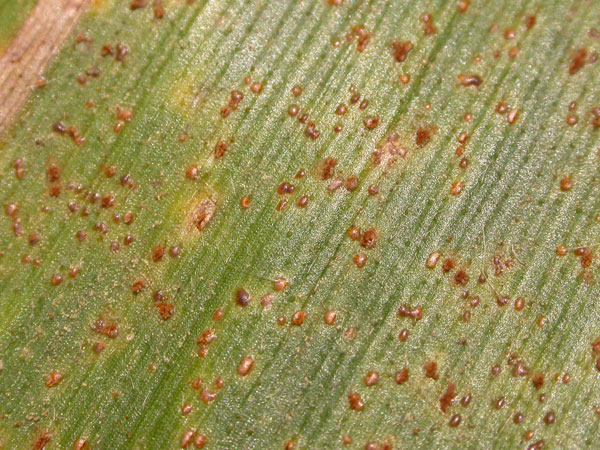 Southern Rust of Corn
Southern Rust of Corn
- Foliar fungal diseases can reduce photosynthetic leaf area and movement of carbohydrates into developing grain
- Disease only develops when the correct pathogen, a susceptible host, and correct environmental conditions for the pathogen cooccur
- Foliar diseases develop over time and the disease cycle repeats. The number of repeating cycles plays a large role in the ultimate impact of the disease on yield
- Scouting and assessing overall risk help to maximize return on investment with fungicide applications in field crops
During the growing season, field crops can succumb to diseases caused by several fungal foliar diseases. Examples include, grey leaf spot, northern corn leaf blight, southern rust, and tar spot in corn, and frogeye leaf spot, Septoria leaf spot, and target spot in soybeans. In order for disease to occur, a pathogenic organism must come into contact with a susceptible plant host, while environmental conditions are favorable for pathogen growth and development. IF any of these conditions are not met, disease does not occur. This interaction is represented by the disease triangle, which is a required slide in almost every plant disease management publication or educational session. For diseases that only have a single disease cycle, or window to cause disease in a season, we have a decent idea of the likelihood that a fungicide application may be useful if weather is conducive and other components of the disease triangle are met. Great examples of this are Fusarium head blight in small grains and white old in soybeans. These diseases only infect during a relatively short period of time during a limited period in crop growth, so as long as we know the pathogen is present in the field, we can somewhat reliably predict disease risk using weather forecasts and environmental data.
Contrast this with foliar fungal diseases. These diseases infect foliage, which starts to develop early in the season, and persists throughout crop maturity. The window that the host is in a susceptible period is much larger than the other diseases previously mentioned. In addition, we all know that weather varies throughout the season. In seasons where we have prolonged periods of humidity/rain, such as 2018 and 2021, foliar diseases develop to significant levels. This is because the pathogens continue to grow, cause symptoms on foliage and produce spores, which can spread to healthy tissues, infect, and repeat the process over time. However, this isn’t a situation that commonly occurs. Often, we have periods where diseases may develop for short periods of time and then stop because environmental conditions are not conducive for disease. A great example of this is common rust of corn. The common rust pathogen needs cool and wet conditions to continue to develop. As a result, we seldom observe this disease during critical phases of corn growth and development during the middle of the summer, as temperatures exceed that which allows the pathogen to grow and develop.
These facts are the reason why thresholds for foliar fungal diseases on field crops are not reliable. There simply are too many moving pieces that can cause a disease to develop rapidly or stop development across a relatively large potential window where disease can occur and reduce yields. For this reason, it is important to understand the factors that increase risk for these diseases and to scout during the season, to assess individual field situations. A good way of evaluating risk can be found by clicking this link.
If you can observe foliar diseases at a level above 3-5% and you are approaching R3 in soybeans or R1 in corn, then a fungicide application may be a good investment at the standard R3 (soybean) or VT/R1 (corn) timings. If diseases start to develop later, the window for these foliar pathogens to develop and cause losses is reduced. In some instances, if we enter a prolonged period of wet weather late (such as 2018 and 2021) then applications made a little later in development may be more efficacious as residual control will last longer into the later phases of grain fill.

Figure 1. A hypothetical example of a foliar fungal pathogen with a repeating lifecycle. In this case, temperature and canopy humidity / leaf wetness are the major drivers of disease progress. In this example, a prolonged period of disease caused the disease to develop through a significant portion of the middle of the season.

Figure 2. A hypothetical example of a foliar fungal pathogen with a repeating lifcycle. In this case, temperature and canopy humidity / leaf wetness are the major drivers of disease progress. In this example, environmental conditions only favored disease development for a short period of time.

Figure 3. A hypothetical example of a foliar fungal pathogen with a repeating lifecycle. In this case, temperature and canopy humidity / leaf wetness are the major drivers of disease progress. Here, disease develops early in the season, but stops for a period mid-season. When conditions are conducive, disease continues to develop later in the season.